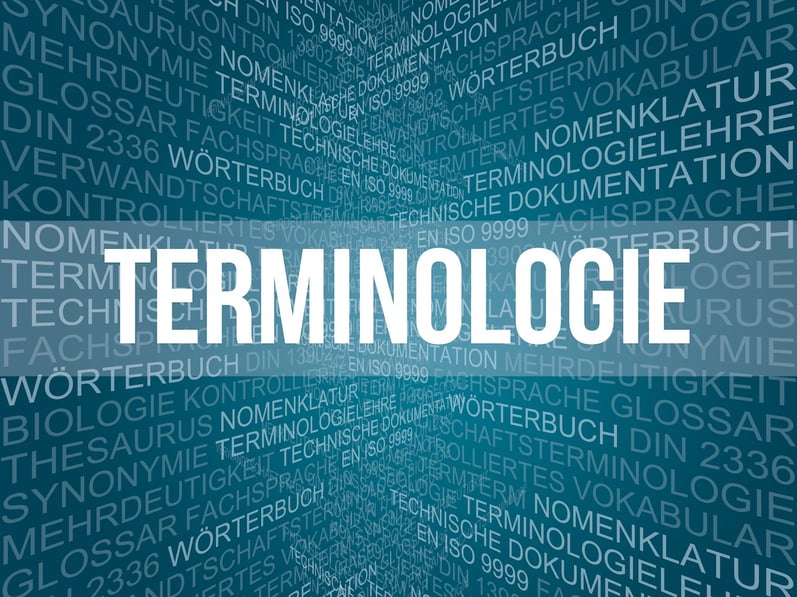
Although every technical editor knows the importance of terminology when it comes to consistent, high-quality translations, often there isn’t the budget or the resources to take terminology projects seriously. But managing your terminology doesn’t have to be a mammoth undertaking. What you need more than anything else is a structured approach that gives you and your translators a useful list of terms.
Most people are aware that well-maintained terminology is crucial to ensure consistent communication, both internally and externally. But many businesses barely give terminology a second thought. If there are lists, they’re usually out of date, with countless double and unusable entries – making them more or less useless for that company’s everyday work and for the translation agency. It doesn’t have to! If you bear a few things in mind, you’ll see that creating a well-structured term base that will help you work better isn’t rocket science.
Creating a term base
Excel lists are widely used for terminology, whether for in-house glossaries or to provide translations of foreign-language terminology – though they aren’t exactly ideal. (We explain how online terminology management can be made easier here.) Of course they can be used, but if you want to send them to your translation agency later on, there are a few rules to follow to make them useful and more effective.
1. Take adjective endings and inflections into account
We recommend asking your agency how best to prepare the Excel list for future use, because it can vary depending on the CAT tool used.
In memoQ, for example, the inflections and roots of words need to be marked – which can be done using the asterisk (*) and the pipe symbol (|).
The asterisk is primarily used with composite words, which occur frequently in German in particular. It serves as a “wildcard”, meaning that anything can follow it: if your term base entry is “Haus*”, for instance, the translator will see the entry if the sentence they’re translating contains “Hausverwaltung” or other terms starting with “Haus”. The pipe symbol | is used for parts of words which don’t change, which means it’s very useful with adjective endings. For example, if your term base entry is “geschützt|er Bereich*” (where “geschützt” is the adjective), memoQ will display this entry even if it appears in the text as “geschütztem Bereichswesen”.
2. Pay attention to capitalization
Terms should be entered in the term base as they appear in running text. So for English, that will usually mean using lower case.
3. Be as clear as possible and avoid synonyms
There’s not much point creating a term base if it contains multiple terms for one particular component. It makes things unclear for the translator, and increases the risk of unwanted inconsistent translations. And this is particularly important if you’re using machine translation, as these ambiguities in terminology will make the machine translation output a mess.
4. Highlight forbidden terms correctly
If there are particular terms you don’t want to use, they can and should be highlighted as forbidden. But that’s only useful if there are no contrary entries suggesting the term is allowed again.
5. Only put one entry / piece of information in each cell
To make your Excel list as easy as possible for the translation agency to use, formatting the Excel list sensibly is just as important as entering the terms correctly. As a basic rule, there should only be one piece of information in each column. For example, you could put the desired English terms in column A, the forbidden German terms in column B, the definitions in column C and the desired German terms in column D.
Why badly managed terminology is a problem
Why go to all this effort? Because if terms aren’t entered correctly, they might not appear in the place where they should when the translator is working on the text as the CAT tool won’t recognize them. Problems can also arise when carrying out a quality assurance check on the finished translations, where it’s not uncommon to find hundreds of incorrect error warnings. It can take hours to look through all these warnings in longer technical documentation – and that’s additional work that could have been avoided.
Well-managed terminology for machine translation
It’s also important to handle terminology correctly if you’re working with machine translation. Not all machine translation tools incorporate term bases, so an extra (carefully prepared) glossary may be required. In any case, though, it’s important to have a well-organized term base so that while post-editing, the translator will see all relevant suggestions and can fix the incorrect terminology in the machine translation output.
Expanding the term base
As well as the new terms to be added for each new product and new text, you can also add definitions and other useful information to enhance your term base. Not only will this make life much easier for translators – it might also help your in-house communication. After all, not every member of staff will be as familiar as you are with the components your business uses.
Maintaining the term base
Term bases need to be maintained regularly in order to remain useful. But if you did the hard work early on and created a well-organized term base, it’s easy to keep it up to date. Terminology doesn’t stand still, so when terms change, don’t just update things in-house – remember to tell your translation agency too. And if you’re actively involved with the agency’s own terminology management system, it’s straightforward to make these changes yourself.
Main image: © Adobe Stock


